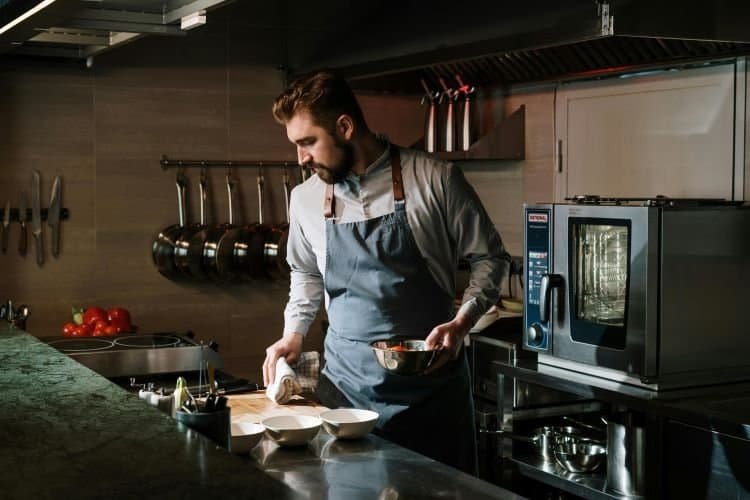Restaurant Management: 9 Steps to Running a Great Shift

What’s the best way to consistently have success in your restaurant?
One of the things I enjoy doing the most is teaching a new manager. While I have various methods of teaching, and every situation is different as people are different in their own right, one method stands out as a staple in my training strategy. That is shift management.
This article is not so much about my training methods, but more about a philosophy. Running a great shift has a tremendous impact on the bottom line of your restaurant’s P&L. I believe that if you run great shifts every day, then your numbers will almost fall into place. It all starts with Step 1.
1. Plan their shift
Every shift starts with a plan. If you’ve read some of my other articles, you’ve likely seen my suggested books. One of those is the Franklin Covey system. That is the system I use daily to plan my shift.
While things don’t always go according to plan, it is the restaurant business after all, and having a good outline for what you want to accomplish in a day will make you…
- More focused on tasks you want to tackle
- Be more effective throughout your day and your week
- Eliminates idle time and brain fog looking for self-direction
Start with a plan, and even if you don’t get everything accomplished, you have a good start on what to focus on for the next shift and the week ahead.
2. The 3 Ps
Walking into your building you should have three things at the top of your mind.
- People
- Product
- Preparedness
Those are the basic key elements of any business, not just the restaurant business. You can’t do anything without your people. They need products to produce, serve, and sell. And you have to prepare them both for what’s coming the door.
One of the most recurring themes in this business is that everything is connected. These three are the core elements of your shift, and they are joined at the hip. Getting one of them out of sync can change the dynamics of your shift and how it flows.
Before we look at each one, what to focus on, and how to be proactive to set yourself up for success, let’s look at how we should approach each aspect.
3. Shift Setup
There are three things to constantly remember, and focus on when dealing with each aspect of the 3 P’s.
- Identify what you have
- Set the expectation
- Follow up accordingly
As we dive into the meat of the shift, you’ll learn how to use each of these guiding principles to lead your shift in the direction you want it to go. You can go about this by asking yourself these questions:
- What or who do I have?
- What or who do I need to have a successful shift?
- Can I get there with what and who I have?
- Do I need more?
- Do I have too much?
- Do I need to adjust? And How?
You want to identify and answer these questions as early as possible in your shift. Having this proactive approach will allow you to react quickly when something unexpected happens. You already know what you have, and you’ve answered yourself on how to adjust if needed.
4. People
We can’t do this alone. Unless you’re running a food truck, and even that’s a tough task. You have to have people, and the right people in place.
Who you schedule for what shift may make all the difference in the world. If you’re delegating schedule writing responsibilities to a key employee, you must check their work every week.
Look at your scheduled staff for each shift and evaluate if they can handle the load each person has been assigned, section, etc.
- Identify what your team looks like for that day
- Set the Expectation of the number of people you need for that shift
- Follow up as needed to meet your shift needs quickly
Start right away if you need to call in extra staff. Unless you are in a position where you need to staff almost the entire restaurant, then don’t spend all your time on it.
It’s okay to run short, you may need to move people around but have a plan nonetheless.
5. Product
The next point of focus to address is our product. Without product, we don’t have a business. And that product needs to be of the highest quality to ensure the success of the current and future shifts.
If you have the right systems and people in place then this issue almost takes care of itself. Some of the things we may have to address are;
- Is prep getting completed promptly
- Are there any product outages or shortages that can be corrected
- How about quality issues? Temperatures etc.
- Are deliveries coming in to address the needs?
- Any equipment issues that need to be addressed
- Fryers on
- Grills working
- Refrigeration working to temperature
Product challenges may come in many different forms throughout your day. Dealing with them quickly and efficiently is not only good practice but becomes a habit over time and eventually second nature.
6. Preparedness
At this point, we are already well on our way to being prepared for an amazing shift. We’ve got our two biggest elements to a successful shift headed towards a win, now we just have to take care of a few details.
- Counting drawers or tills
- BATHROOMS! Stocked & Spotless – Period.
- The dining area is clean and ready
- Silverware
- Tables set
- Blinds / Shades position
- Set your ambience
- Lighting
- Music
- Temperature
- Fireplace if you have one
- Floorplan in place – servers
In other words, are you ready to give your guests the best experience when they walk through your door? You have to put your best foot forward, every shift, every day.
7. The 4th P…or two?
So what’s the fourth P? Or…two?
I phrase it that way simply because many people call it many different names. But it is the Property or Physical Property. This is your building. But it’s much more than that.
While this aspect goes right along with the first two P’s, I decided to list it here because of the amount of variables that go with it. I also didn’t want to distract from the importance of the first two elements.
However, this aspect is approached differently by individual managers due to several factors. Including:
- How one commutes to work
- The property itself
- Stand alone building
- Shopping or Row Center
- Mall or Food court
- Etc.
Assessing your property actually happens before you ever get in the building.
Regardless of your building type, you should at the least be doing a security check when approaching.
If you drive and have a stand-alone facility drive around your building twice:
- First Pass – Security
- Be alert
- Check the back door – secure
- No one suspicious hanging around
- Look at your windows – intact and secure
- Front Door Security
- Gated Areas are still locked
- Second pass
- This pass is about curb appeal
- Exterior Lights – All working
- Landscaping upkeep
- Parking lot clean
- The dumpster area is clean and locked
- Signage in good repair
If you walk to work or take public transportation then you likely live in a major city and have a unit in a row of shops or a center. If this is the case the basics of security and curb appeal are the same. You just need to adjust them to fit your specific needs.
8. Showtime
It’s Showtime! Let’s open the doors! Not so fast…
Right before I unlock the door and turn on the open sign, I always do one final walk-through. I’m just revisiting everything we’ve already covered but looking for a few things from an expectation standpoint.
- Back of the House
- Prep is finished or being wrapped up
- Line Quality Check
- Temperatures
- Food looks amazing
- Floors – Dry and Swept
- Dish area set up
- All deliveries put away
- Trash taken out
- Back Door secure
- Front of the House
- Everyone Showed up
- Appearance / Attire clean and straight
- Host Area set up
- Dining Room looks amazing
- The server line is set and ready
Now… It’’s Showtime!
We want everything tidy and ready to do one thing, and only one thing. That is; Rock our guest’s world with the best food and service we can give them. We don’t want anything to distract from that as our main objective.
9. Setup the next shift
Now that we’ve set up an amazing shift for ourselves, let’s get to work on taking care of our fellow management team, if we have them. Otherwise, we’re setting ourselves up for a successful day tomorrow, or perhaps our evening shift.
So how do we go about that? The same we went about our shift:
- People
- Product
- Physical Property
Whoever follows us on our next shift, we want to set them up for success. We want them to have the best possible shift they can have, so we are all working together to achieve the goals of the restaurant.
Let’s Wrap Up
Running a great shift is all about consistency in your approach. A great shift manager makes running a shift look effortless at times. Mostly because it should be. If you have a plan and know what your goals are for each day, shift management becomes second nature.
If you have anxiety about shift management, then having a plan can ease your mind. Just like anything in the restaurant business, it takes practice. The more you do a thing the better you become at it.
If you’re new at management and this area challenges you, try this approach and see if it doesn’t at least make you more confident going into your shifts. Let’s make it easy! Let’s make your next shift, your best shift!






